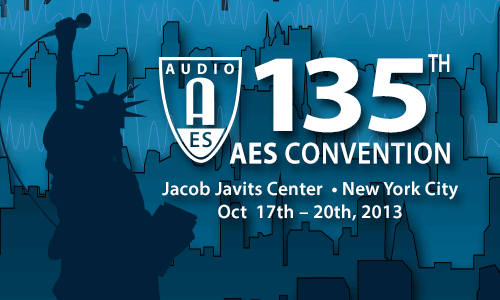AES New York 2013
Paper Session P11
Friday, October 18, 2:15 pm — 4:45 pm (Room 1E09)
Paper Session: P11 - Perception—Part 1
Chair:
Jason Corey, University of Michigan - Ann Arbor, MI, USA
P11-1 On the Perceptual Advantage of Stereo Subwoofer Systems in Live Sound Reinforcement—Adam J. Hill, University of Derby - Derby, Derbyshire, UK; Malcolm O. J. Hawksford, University of Essex - Colchester, Essex, UK
Recent research into low-frequency sound-source localization confirms the lowest localizable frequency is a function of room dimensions, source/listener location, and reverberant characteristics of the space. Larger spaces therefore facilitate accurate low-frequency localization and should gain benefit from broadband multichannel live-sound reproduction compared to the current trend of deriving an auxiliary mono signal for the subwoofers. This study explores whether the monophonic approach is a significant limit to perceptual quality and if stereo subwoofer systems can create a superior soundscape. The investigation combines binaural measurements and a series of listening tests to compare mono and stereo subwoofer systems when used within a typical left/right configuration.
Convention Paper 8970 (Purchase now)
P11-2 Auditory Adaptation to Loudspeakers and Listening Room Acoustics—Cleopatra Pike, University of Surrey - Guildford, Surrey, UK; Tim Brookes, University of Surrey - Guildford, Surrey, UK; Russell Mason, University of Surrey - Guildford, Surrey, UK
Timbral qualities of loudspeakers and rooms are often compared in listening tests involving short listening periods. Outside the laboratory, listening occurs over a longer time course. In a study by Olive et al. (1995) smaller timbral differences between loudspeakers and between rooms were reported when comparisons were made over shorter versus longer time periods. This is a form of timbral adaptation, a decrease in sensitivity to timbre over time. The current study confirms this adaptation and establishes that it is not due to response bias but may be due to timbral memory, specific mechanisms compensating for transmission channel acoustics, or attentional factors. Modifications to listening tests may be required where tests need to be representative of listening outside of the laboratory.
Convention Paper 8971 (Purchase now)
P11-3 Perception Testing: Spatial Acuity—P. Nigel Brown, Ex'pression College for Digital Arts - Emeryville, CA, USA
There is a lack of readily accessible data in the public domain detailing individual spatial aural acuity. Introducing new tests of aural perception, this document specifies testing methodologies and apparatus, with example test results and analyses. Tests are presented to measure the resolution of a subject's perception and their ability to localize a sound source. The basic tests are designed to measure minimum discernible change across a 180° horizontal soundfield. More complex tests are conducted over two or three axes for pantophonic or periphonic analysis. Example results are shown from tests including unilateral and bilateral hearing aid users and profoundly monaural subjects. Examples are provided of the applicability of the findings to sound art, healthcare, and other disciplines.
Convention Paper 8972 (Purchase now)
P11-4 Evaluation of Loudness Meters Using Parameterization of Fader Movements—Jon Allan, Luleå University of Technology - Piteå, Sweden; Jan Berg, Luleå University of Technology - Piteå, Sweden
The EBU recommendation R 128 regarding loudness normalization is now generally accepted and countries in Europe are adopting the new recommendation. There is now a need to know more about how and when to use the different meter modes, Momentary and Short term, proposed in R 128, as well as to understand how different implementations of R 128 in audio level meters affect the engineers’ actions. A method is tentatively proposed for evaluating the performance of audio level meters in live broadcasts. The method was used to evaluate different meter implementations, three of them conforming to the recommendation from EBU, R 128. In an experiment, engineers adjusted audio levels in a simulated live broadcast show and the resulting fader movements were recorded. The movements were parameterized into “Fader movement,” “Adjustment time,” “Overshoot,” etc. Results show that the proposed parameters produced significant differences caused by the meters and that the experience of the engineer operating the fader is a significant factor.
Convention Paper 8973 (Purchase now)
P11-5 Validation of the Binaural Room Scanning Method for Cinema Audio Research—Linda A. Gedemer, University of Salford - Salford, UK; Harman International - Northridge, CA, USA; Todd Welti, Harman International - Northridge, CA, USA
Binaural Room Scanning (BRS) is a method of capturing a binaural representation of a room using a dummy head with binaural microphones in the ears and later reproducing it over a pair of calibrated headphones. In this method multiple measurements are made at differing head angles that are stored separately as data files. A playback system employing headphones and a headtracker recreates the original environment for the listener, so that as they turn their head, the rendered audio during playback matches the listeners' current head angle. This paper reports the results of a validation test of a custom BRS system that was developed for research and evaluation of different loudspeakers and different listening spaces. To validate the performance of the BRS system, listening evaluations of different in-room equalizations of a 5.1 loudspeaker system were made both in situ and via the BRS system. This was repeated using three different loudspeaker systems in three different sized listening rooms.
Convention Paper 8974 (Purchase now)

